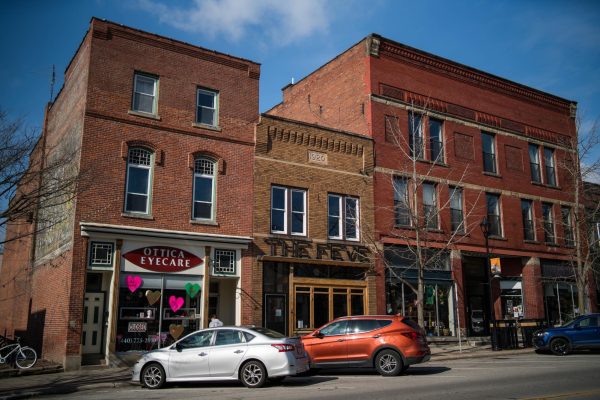Student Organizes Invasive Species Removal in Environmental Activism Initiative
On Saturday, April 22, a dozen Oberlin students, accompanied by City of Oberlin Storm Water Coordinator Jennifer Reeves, set out from the Adam Joseph Lewis Center for Environmental Studies with snacks, bags, and tools in hand on a mission to remove invasive Japanese knotweed from the banks of Plum Creek.
“I wanted to do something for Oberlin,” College second-year and event organizer Noah Hamaoui said. “We come here for four years, and then we take a bunch of resources [from] the town, make housing so much more expensive here than it would be, and leave. It’s important for us to contribute to the town however we can.”
Hamaoui came up with the idea after participating in a freshwater and community conservation externship. Wanting to relate her research to Oberlin, she got in touch with Reeves to learn about local issues relating to freshwater conservation. Reeves brought up the Japanese knotweed, which has been plaguing Oberlin but for which solutions have not been sufficiently funded. So, with advice from Reeves and the help of a research grant from the National Geographic Society and The Nature Conservancy, Hamaoui decided to create a community action day around the removal of Japanese knotweeds.
She hopes this project might pave the way for future funding from the City of Oberlin to further address the issue.
“If it was [successful], that’s something that we could show the City of Oberlin and be like, ‘Hey, why don’t you create a budget? We have an approach that works,’” Hamaoui said.
Japanese knotweed, a thick plant with deep roots called rhizomes and an aggressive ability to reproduce, was introduced to the United States in the late 1800s. In Oberlin, it has dominated over native plants in resource consumption.
The decreased biodiversity resulting from this becomes an issue for freshwater ecosystems when the weed grows alongside rivers and creeks, as it often does. Japanese knotweed does not last year-round, but rather grows in the spring and dies in the winter. Because it has outcompeted all other vegetation where it grows, the soil it resides in is left defenseless during the winter. Without plants to stabilize it and protect it from direct rainfall, the soil becomes more vulnerable to erosion and can end up polluting the water with runoff.
“If you have very sediment-heavy water, you’re going to choke out anything that needs to breathe that water because it won’t be able to process the oxygen,” Reeves said.
In order to remove the Japanese knotweed along a section of Plum Creek, the student volunteers engaged in part one of a two-step process.
As they stood around a picnic table, pulling on gloves, Reeves explained the first step. They would each split into pairs or trios, armed with a can of spray paint and pruning shears. As they worked, they would mark off squares around the weeds before moving in to cut them at the base of their stems, throwing the plants into large paper bags to be properly disposed of later.
Over the course of three hours, the volunteers cleared an entire section of the bank, shedding clothing layers as the sun came out and venturing down the steep incline on the side of the bank to better attack the weeds.
“The before and after was really noticeable,” Luke Moeller, a first-year who helped with the Japanese knotweed removal on Saturday, said. “Being able to see the progress that we made was really helpful and really inspiring.”
In the fall, Reeves will return with herbicide. The plants, already weakened from being cut and in the process of sending all their energy down to the roots, will be more vulnerable to the weed killer. The spray will get transferred through the stem to the rhizomes, further damaging them.
Both Hamaoui and Reeves acknowledged that using herbicide is not ideal.
“When it comes down to it, that’s the only thing that has been shown to work on these plants, so I am trying to go on the best practices of what is shown to be successful,” Reeves said.
In three hours, the volunteers were able to successfully clear a patch of Japanese knotweed by Plum Creek. To eradicate the entire population from the City of Oberlin, many more volunteers, and many more work days are needed.
Looking to the future, Hamaoui hopes to sponsor a community-based project with Oberlin College’s Environmental Studies department.
“Every semester, I would have people help me,” Hamaoui said. “If it’s in the spring, it will be cutting it, and if it’s in the fall, after the herbicide is applied, we’ll be planting a mix of native Ohio blends to go in that space and not allow it to grow again.”
Reeves believes that engaging the community in projects like this is important.
“It’s great if something is just done, but it’s even better if people understand why and what’s going on,” Reeves said. “Being engaged helps you feel an ownership and a connection to where you are and what you’re doing.”
When it comes to approaching environmental activism such as this, Hamaoui stressed the importance of listening to members of the community the issue affects.
“Whatever community or region that you’re working with, you have to listen to the people who live there because they are going to know different things than the scientists, who have been doing Ph.D. [programs] on that issue, will know,” Hamaoui said. “I guess this was my way of listening to the community and giving back.”






